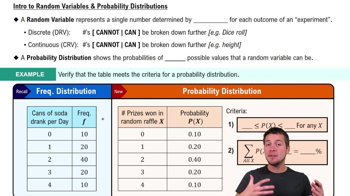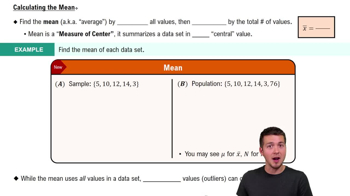Forecast and Actual Temperatures Listed below are actual temperatures (°F) along with the temperatures that were forecast five days earlier (data collected by the author). Use a 0.05 significance level to test the claim that differences between actual temperatures and temperatures forecast five days earlier are from a population with a mean of 0°F.
Table of contents
- 1. Intro to Stats and Collecting Data1h 14m
- 2. Describing Data with Tables and Graphs1h 55m
- 3. Describing Data Numerically2h 5m
- 4. Probability2h 16m
- 5. Binomial Distribution & Discrete Random Variables3h 6m
- 6. Normal Distribution and Continuous Random Variables2h 11m
- 7. Sampling Distributions & Confidence Intervals: Mean3h 23m
- Sampling Distribution of the Sample Mean and Central Limit Theorem19m
- Distribution of Sample Mean - Excel23m
- Introduction to Confidence Intervals15m
- Confidence Intervals for Population Mean1h 18m
- Determining the Minimum Sample Size Required12m
- Finding Probabilities and T Critical Values - Excel28m
- Confidence Intervals for Population Means - Excel25m
- 8. Sampling Distributions & Confidence Intervals: Proportion1h 12m
- 9. Hypothesis Testing for One Sample3h 29m
- 10. Hypothesis Testing for Two Samples4h 50m
- Two Proportions1h 13m
- Two Proportions Hypothesis Test - Excel28m
- Two Means - Unknown, Unequal Variance1h 3m
- Two Means - Unknown Variances Hypothesis Test - Excel12m
- Two Means - Unknown, Equal Variance15m
- Two Means - Unknown, Equal Variances Hypothesis Test - Excel9m
- Two Means - Known Variance12m
- Two Means - Sigma Known Hypothesis Test - Excel21m
- Two Means - Matched Pairs (Dependent Samples)42m
- Matched Pairs Hypothesis Test - Excel12m
- 11. Correlation1h 6m
- 12. Regression1h 50m
- 13. Chi-Square Tests & Goodness of Fit1h 57m
- 14. ANOVA1h 57m
9. Hypothesis Testing for One Sample
Steps in Hypothesis Testing
Problem 8.5.11
Textbook Question
Randomization: Testing a Claim About a Mean
In Exercises 9–12, use the randomization procedure for the indicated exercise.
Section 8-3, Exercise 23 “Cell Phone Radiation”
 Verified step by step guidance
Verified step by step guidance1
Identify the null hypothesis (H₀) and the alternative hypothesis (H₁). For this problem, the null hypothesis typically states that the mean is equal to a specific value (e.g., μ = μ₀), while the alternative hypothesis states that the mean is different (e.g., μ ≠ μ₀).
Determine the test statistic to be used. For testing a claim about a mean, the test statistic is often calculated as: , where is the sample mean, is the hypothesized population mean, is the sample standard deviation, and is the sample size.
Simulate the randomization distribution. Randomly shuffle or resample the data under the assumption that the null hypothesis is true. This involves creating a large number of simulated datasets where the mean is fixed at the hypothesized value, .
Calculate the test statistic for each simulated dataset. This will create a distribution of test statistics under the null hypothesis, which is called the randomization distribution.
Compare the observed test statistic to the randomization distribution. Determine the p-value by finding the proportion of simulated test statistics that are as extreme or more extreme than the observed test statistic. Use this p-value to decide whether to reject or fail to reject the null hypothesis based on the significance level (e.g., α = 0.05).
 Verified video answer for a similar problem:
Verified video answer for a similar problem:This video solution was recommended by our tutors as helpful for the problem above
Video duration:
4mPlay a video:
Was this helpful?
Key Concepts
Here are the essential concepts you must grasp in order to answer the question correctly.
Randomization
Randomization is a statistical technique used to assign subjects to different groups in a way that eliminates bias. This process ensures that each participant has an equal chance of being placed in any group, which helps to create comparable groups and allows for valid inferences about the population. In hypothesis testing, randomization can be used to simulate the distribution of a test statistic under the null hypothesis.
Recommended video:
Guided course

Intro to Random Variables & Probability Distributions
Mean
The mean, often referred to as the average, is a measure of central tendency that summarizes a set of values by dividing the sum of those values by the number of observations. It provides a single value that represents the entire dataset, making it easier to understand the overall trend. In hypothesis testing, the mean is often compared to a hypothesized value to determine if there is enough evidence to reject the null hypothesis.
Recommended video:
Guided course

Calculating the Mean
Hypothesis Testing
Hypothesis testing is a statistical method used to make decisions about a population based on sample data. It involves formulating a null hypothesis (H0) and an alternative hypothesis (H1), then using sample data to determine whether to reject H0. The process includes calculating a test statistic and comparing it to a critical value or using a p-value to assess the strength of the evidence against H0, guiding conclusions about the population parameter.
Recommended video:
Guided course

Step 1: Write Hypotheses

 6:21m
6:21mWatch next
Master Step 1: Write Hypotheses with a bite sized video explanation from Patrick
Start learningRelated Videos
Related Practice
Textbook Question
